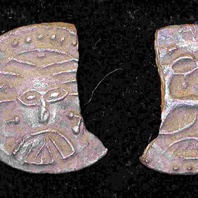
Viking Objects
Danish Silver Sceat (LEIC-5608D1)
This silver sceat is classified as part of the Danish Series X Type 31. The obverse depicts the head of Woden with crosses to either side of a rounded beard and pellet above. The reverse depicts a monster facing left. These coins are considered to be associated with the early trading center at Ribe in Denmark. It is very likely that they made their way to England by means of Vikings.
Read More
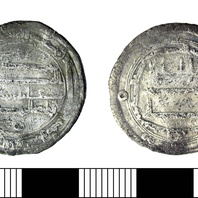
Viking Objects
Silver Dirham (DENO-07CCA4)
A complete silver dirham of Madinat al-Salam (Baghdad) reign of al-Mahdi Billah, 163 AH (780 AD). The dirham was a unit of weight used across North Africa, the Middle East, and Persia, with varying values which also referred to the type of coins used in the Middle East during the Viking Age. These coins were extremely prized possessions not only for their silver value but as a way of displaying one’s wealth and vast trade connections. Millions of Arabic dirhams would have been imported throughout the Viking world and are mostly found in hoards.
Read More
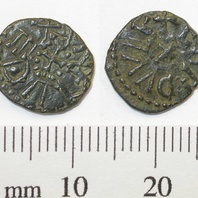
Viking Objects
Northumbrian Styca (DENO-87CE96)
This copper-alloy styca was minted by the moneyer Eardwulf in the name of King Ethelred II of Northumbria during his second reign. While Wessex and Mercia were using silver coinage as part of their monetary economy, Northumbria was using copper coins known as stycas, which may have contained trace amounts of silver. The concentration of these coins at sites such as Torksey and ARSNY suggests that they could have remained in circulation after the fall of Northumbria in 866 but were taken to the sites by the Vikings during their campaigning. they were not much use to the Vikings within their silver-based bullion economy but it is suggested that they were treated as raw material and were used as commodity money instead. The evidence for the production of copper-alloy strap-ends at Torksey and ARSNY supports this idea that the stycas were used for production.
Read More

Viking Objects
Samanid Silver Dirham (NCL-544D22)
A silver Samanid dirham of al-Shash dated possibly to 912 AD. The dirham was a unit of weight used across North Africa, the Middle East, and Persia, with varying values which also referred to the type of coins used in the Middle East during the Viking Age. These coins were extremely prized possessions not only for their silver value but as a way of displaying one’s wealth and vast trade connections. Millions of Arabic Dirhams would have been imported throughout the Viking world and are mostly found in hoards. Arabic dirhams demonstrate contact between the Viking diaspora and the Arabic world. Arabic coins are especially useful for dating sites, because they carry the date when they were minted. This permits precise dating where the part of the coin with the date survives, whereas European coins can only be dated to the reign of the ruler depicted on them. In western descriptions of these coins, the Arabic dates found on the coins are usually listed in square brackets, as above, and the European equivalent is listed after it.
Read More
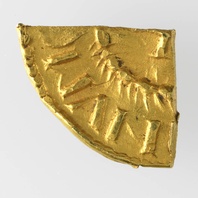
Viking Objects
Imitation Carolingian Gold Solidus (CM.521-1998)
This cut-quarter of an imitation gold solidus is one of 80 known imitations as opposed to 15 official solidi and is a copy of coins issued by Louis the Pious (778-840 CE). It was probably made somewhere in Frisia on the north-west coast of what is now the Netherlands. The importance of this carefully divided quarter-coin is as evidence for the acceptance of solidi on its actual monetary value rather than as mere bullion in the 9th century; if it were hack-gold it would not have been cut so meticulously. The Vikings would have obtained real and imitation Carolingian coins through their raiding and trading activities in the Frankish Empire.
Read More
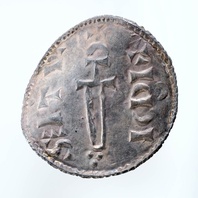
Viking Objects
Sihtric Caoch Silver Penny (CM.863-2002)
A sword and cross type silver penny of Sihtric Caoch (Sihtric Cáech) minted for the Viking kingdom of Northumbria. Sihtric Caoch was the Scandinavian ruler of Dublin from 917-920 CE and subsequently the ruler of Northumbria from 921-927 CE. It is not certain why he left Ireland. The Irish annals state that it was ‘through the grace of God’ and do not elaborate on the politics behind his departure. After the establishment of the Danelaw, some Viking leaders decided to mint their own coins to solidify their legitimacy in the eyes of the local populace. This created a hybrid economy where some members of the Danelaw used bullion and others used coins. This coin was part of a hoard of twelve coins found at Thurcaston between 1992 and 2000. The coins are Anglo-Saxon, Arabic and Viking issues, and show the diverse and wide-ranging contacts between societies at this time. The hoard was probably deposited c.923-925 CE, approximately five years after Leicester had been retaken by Mercia (c.918 CE). They indicate that a bullion economy was still operating in the Danelaw as late as the 920s. This suggests that the reconquest did not manage to institute Anglo-Saxon practices such as a monetary economy immediately.
Read More
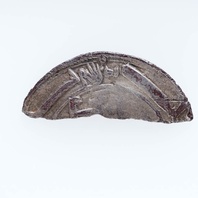
Item
Abbasid Silver Dirham Fragment (CM_1770_2008)
This fragment of a silver dirham was minted for the Abbasid ruler at Madinat al-Salam, [180-183] 796-799 CE . The dirham was a unit of weight used across North Africa, the Middle East, and Persia, with varying values which also referred to the type of coins used in the Middle East during the Viking Age. These coins were extremely prized possessions not only for their silver value but as a way of displaying one’s wealth and vast trade connections. Millions of Arabic Dirhams would have been imported throughout the Viking world and are mostly found in hoards. Arabic dirhams like this one from Torksey demonstrate contact between the Viking diaspora and the Arabic world. Arabic coins are especially useful for dating sites, because they carry the date when they were minted. This permits precise dating where the part of the coin with the date survives, whereas European coins can only be dated to the reign of the ruler depicted on them. In western descriptions of these coins, the Arabic dates found on the coins are usually listed in square brackets, as above, and the European equivalent is listed after it. This coin is a product of the Abbasid Caliphate which was ruled from its capital in Baghdad. The Abbasid Caliphate was at its greatest extent c.850 CE, occupying lands from Morocco in the west to Afghanistan in the east.
Read More
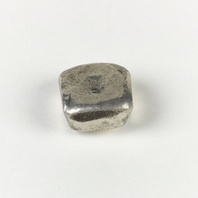
Viking Objects
Reproduction Square Weight
A square lead alloy weight based on one found in Nottinghamshire. It weighs 20g.
Read More
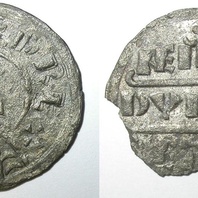
Viking Objects
Coin of Alfred the Great (1989-58/3381)
This silver penny from the mass grave at Repton was minted by a moneyer called Dudwine in Canterbury for Alfred the Great. Alfred was King of Wessex from 871 to 899 and spent most of his reign fighting off Viking invasions. He won a decisive victory at the Battle of Edington in 878 which resulted in a peace with the Vikings and the creation of the Danelaw. Minting coins was a way of controlling the means of exchange within a kingdom and which created a more easily administered standardized system of trade. Moreover, the coins themselves were often used as propaganda, portaying symbols and statements that gave off a desired message. The Vikings later used the minting of coins to legitimize their own rule.
Read More
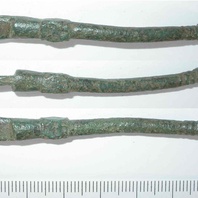
Viking Objects
Scale Arm Fragment (DENO-0619F7)
Folding balances of the type to which this arm belongs are known from the late Anglo-Saxon period and are quite common from the medieval period. The dating of this artefact is therefore somewhat problematic. Scales were a common commerical tool and would have been an important part of any exchange whether using a monetary system or a bullion system, such as the one that existed in Viking-occupied areas of England.
Read More
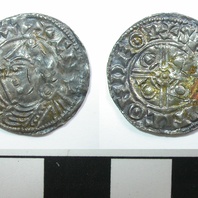
Viking Objects
Silver Penny (1960/459-2)
This silver penny was minted in Derby for King Cnut the Great, the Danish king who reigned over England from 1016-1035. It is not known precisely where it was found. Minting coins was a way of controlling the means of exchange within a kingdom and which created a more easily administered standardized system of trade. Moreover, the coins themselves were often used as propaganda, portaying symbols and statements that gave off a desired message. The Vikings later used the minting of coins to legitimize their own rule.
